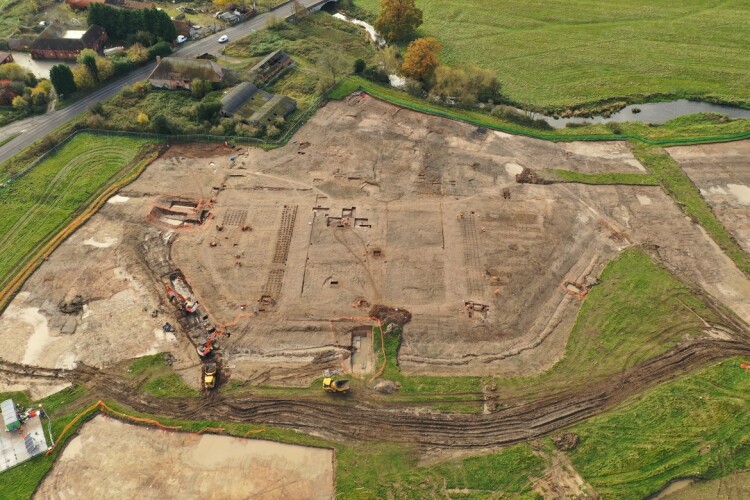The excavations were undertaken by Wessex Archaeology for LM (a joint venture of Laing O’Rourke and Murphy) on the HS2 site at Coleshill in Warwickshire.
The remains of Coleshill Manor and an octagonal moat were originally noticed in aerial photographs. As excavations progressed, the remains of a massive garden dating from the decades either side of 1600 were discovered, alongside the manor house.
The house was owned by Sir Robert Digby, and experts now believe that after marrying an Irish heiress, he built his home in the modern style, along with huge formal gardens, 300-metres long.
Entirely unknown before, the preservation of the gardens is described as exceptional, with well-preserved gravel paths, planting beds, garden pavilion foundations and ornaments organised in a geometric pattern. The site is being compared to the ornamental gardens at Kenilworth Castle and Hampton Court Palace.
Wessex Archaeology’s project officer, Stuart Pierson, said: “For the dedicated fieldwork team working on this site, it’s a once in a career opportunity to work on such an extensive garden and manor site, which spans 500 years. Evidence of expansive formal gardens of national significance and hints of connections to Elizabeth I and the civil war provide us with a fascinating insight into the importance of Coleshill and its surrounding landscape.

“From our original trench evaluation work, we knew there were gardens, but we had no idea how extensive the site would be. As work has progressed, it’s been particularly interesting to discover how the gardens have been changed and adapted over time with different styles. We’ve also uncovered structures such as pavilions and some exceptional artefacts including smoking pipes, coins and musket balls, giving us an insight into the lives of people who lived here.
“The preservation of the gardens is unparalleled. We’ve had a big team of up to 35 archaeologists working on this site over the last two years conducting trench evaluations, geophysical work and drone surveys as well as the archaeological excavations.”
Paul Stamper, a specialist in English gardens and landscape history, said: “This is one of the most exciting Elizabethan gardens that has ever been discovered in this country. The scale of preservation at this site is really exceptional and is adding considerably to our knowledge of English gardens around 1600. There have only been three or four investigations of gardens of this scale over the last 30 years, including Hampton Court, Kirby in Northamptonshire and Kenilworth Castle, but this one was entirely unknown. The garden doesn’t appear in historical records, there are no plans of it, it’s not mentioned in any letters or visitors’ accounts.
“The form of the gardens suggest they were designed around 1600, which fits in exactly with the documentary evidence we have about the Digby family that lived here. Sir Robert Digby married an Irish heiress, raising him to the ranks of the aristocracy. We suspect he rebuilt his house and laid out the huge formal gardens measuring 300 metres from end to end, signifying his wealth.”
Got a story? Email news@theconstructionindex.co.uk



